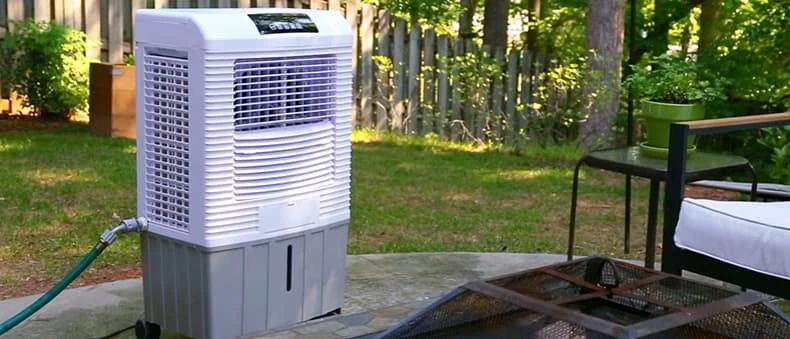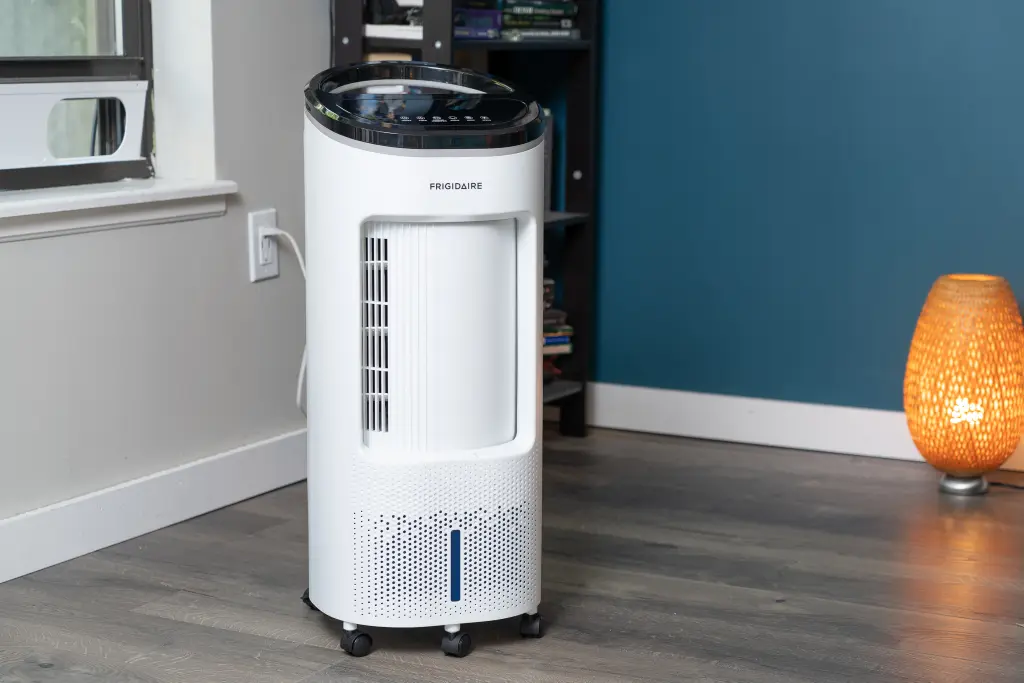Imagine it’s a stifling summer day on the Mornington Peninsula, the kind where the Australian sun bakes everything under a clear blue sky. You’re looking for relief and maybe sipping something cool. Enter the mobile evaporative cooler, a clever way to turn dry heat into a refreshing, humidified breeze.
Think of a portable breeze-maker built for the Aussie bush: we’ll dive into why these units thrive in dry climates and how they can save you money, energy, and keep you more comfortable.
How Evaporative Cooling Works
A mobile evaporative cooler (often called a “swamp cooler”) isn’t magic, but it feels close. Picture this: a fan draws hot outdoor air into the unit and forces it through pads soaked with water. As the air passes over the wet pads, the water evaporates—just like sweat cooling your skin.
The result? The air that blows out is noticeably cooler (and yes, a bit more humid). It’s essentially nature’s AC: no refrigerant needed, just water and airflow.
The key parts are simple: a fan, a water reservoir, and the evaporative media (cooling pads). Because it uses water evaporation instead of a big compressor, the energy draw is minimal—mostly just powering a fan and a small pump. In practice, you’re running a high-efficiency fan, not a giant refrigerator unit.
Why Dry Climates Love Evaporative Coolers
If you live in a hot, dry place (like the Aussie outback or even Melbourne’s dry summers), evaporative cooling is your ally. Dry air eagerly absorbs moisture, so a mobile evaporative cooler can literally scrub heat out of the air by adding cool mist.
As one Aussie guide puts it, “on a hot, dry summer day, an evaporative cooler will provide sweet relief for everyone at home.” The Mornington Peninsula, with its warm sunny days and relatively low humidity, is practically made for this kind of cooling.
By contrast, try the same trick on a muggy Queensland afternoon and it falls flat. In high-humidity conditions the air is already saturated, so the cooler can’t evaporate much more water. In fact, experts warn that evaporative coolers become almost useless in very humid climates.
The cooler will still blow air, but it won’t feel super cold and it just keeps adding moisture to the air. For Mornington locals, this isn’t usually a worry on most summer days, but it’s good to know the limits.
Also Read: How Often Should You Do Aircon Servicing Mornington Peninsula?
Cool Comfort: Key Benefits of a Mobile Evaporative Cooler
Let’s get into the sweet perks of owning one of these desert-like cooling machines:
- Energy Efficiency: Think big savings. A mobile evaporative cooler can use up to about 75% less electricity than a standard air conditioner. No wonder – you’re just running a pump and fan, not a power-hungry compressor. Over a long summer, that adds up to a much lower power bill.
- Moisturized Air: Unlike an AC that blasts out bone-dry air, a mobile evaporative cooler keeps the humidity in check. That means less dry-skin and scratchy-throat syndrome. It literally “adds some much-needed moisture to the air,” which can really help if your nose and throat are irritated by too much dry heat.
- Eco-Friendly: These coolers are green champions. They rely on just water and a fan—no ozone-depleting refrigerants, no heavy compressors. They burn far less electricity too, so your carbon footprint shrinks. In short: you’re chilling out with minimal environmental guilt.
- Cost-Effective: From the very start, these units are easier on the wallet. The purchase price is often lower than a like-for-like AC, and because of the low energy usage, you keep saving month after month. Think of it as an investment that pays for itself.
- Better Air Quality: With a swamp cooler, windows or doors usually stay ajar. That means fresh outdoor air is constantly being pulled in and circulated, rather than reusing stale indoor air. Plus, the cooling pads trap dust and pollen. You end up with a steady breeze of cleaner, fresher air – a natural little purifying bonus.
- Portability: As the name suggests, these units are mobile. Most come on wheels or with handles, letting you roll cool air to exactly where it’s needed. Hosting an outdoor pizza night on the deck? Just wheel it out there. Working in your garage? Bring it in. The flexibility is a big win for changing needs.

When (and Where) to Use a Mobile Evaporative Cooler
These coolers excel in specific conditions. The Australian Government’s home design guide confirms it: “mechanical evaporative coolers have been common in drier climates” and generally use far less energy than conventional air conditioning. In plain English – if it’s low-humidity and high-heat, like a Peninsula summer afternoon, bring on the swamp cooler.
That said, placement and ventilation matter. You’ll usually want at least one window or door slightly open so air can flow. The idea is to pull warm air in and let cool air push through – essentially creating a breeze path. If the house is sealed up tight, even the best evaporative cooler can only do so much.
Also, keep the cooling pads clean – especially if your tap water is hard. Minerals can cake up on the pads over time, reducing efficiency (so a quick clean or pad replacement now and then is smart).
On those rare muggy days, the evaporative magic wanes. You’ll notice the output isn’t as chilly, since the air can’t absorb more moisture. After all, in a sauna-like environment, blowing more humidity won’t cool you down any further.
During very humid spells, a conventional AC or dehumidifier might serve better. But for most Mornington summers, you’ll find the portable cooler cuts through the heat like a cool breeze through eucalyptus.
Mobile Evaporative Cooler vs. Traditional AC
Here’s a quick comparison of how a portable evaporative cooler stacks up against a standard air conditioner:
| Feature | Mobile Evaporative Cooler | Traditional AC |
|---|---|---|
| Cooling method | Air blows over water-soaked pads, cooling by evaporation | Uses a refrigerant cycle (compressing/decompressing gas) |
| Energy consumption | Very low – often ~75% less power than AC | High – runs compressor and fans continuously |
| Air humidity effect | Raises humidity (adds moisture to dry air) | Lowers humidity (extracts moisture) |
| Ideal climate | Hot, dry conditions (like Mornington summers) | Effective in any climate (especially humid) |
| Running cost | Low (fan & pump only) | Higher (compressor load) |
| Environmental impact | Low – uses only water, no greenhouse refrigerant | Higher – uses refrigerants and more power |
Conclusion
In short, a mobile evaporative cooler is practically tailor-made for the Mornington Peninsula’s dry heat. It’s energy-smart, environmentally friendly, and kinder to your parched skin and airways than a blast of dry AC. In my own experience, swapping a barbie-side fan for a swamp cooler turned a late afternoon cook-up into a cool, breezy hangout – and I’m still telling my mates about it!
So next time the mercury rises, consider giving your home that oasis treatment. A mobile evaporative cooler can keep you comfortably cool and cut your energy bill. For your next cooling solution, think about choosing a mobile evaporative cooler – your wallet (and your skin) will thank you.
If this article helped you chill out mentally, share it with a friend who’s sweating it out and let us know your own cooling tips in the comments. Stay cool, folks!
Frequently Asked Questions (FAQs)
Do mobile evaporative coolers work well in humid climates?
Not really. They shine in dry climates because the air can absorb more moisture, which creates that cool, fresh breeze. In high humidity, the cooling effect drops off because the air is already saturated with water.
How much water does a mobile evaporative cooler use?
It depends on the model and fan speed, but most units use between 4–10 litres per hour. That’s still much less energy and cost compared to running a refrigerated air conditioner.
Can I use a mobile evaporative cooler indoors?
Yes — but you’ll want to keep a door or window slightly open to let warm air escape and fresh air circulate. Unlike traditional AC, they work best with constant airflow.
Are they expensive to run?
Nope. That’s one of their biggest selling points. Most models use about the same amount of electricity as a standard fan, which makes them far cheaper to operate than refrigerated cooling systems.

